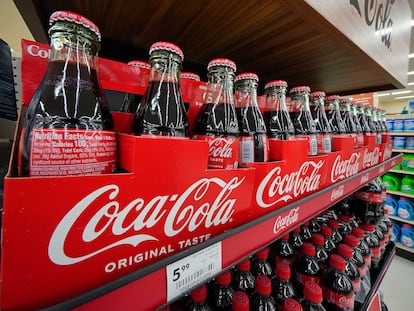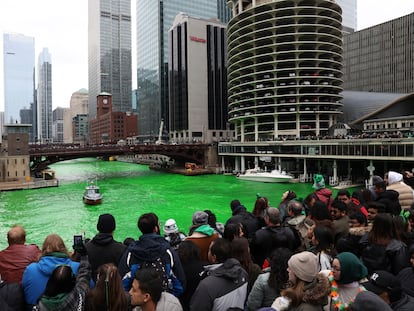Fritz-kola, a drink created by two German students to challenge Coca-Cola with the highest legal amount of caffeine
The beverage, which started as an idea one night over frozen pizza 20 years ago, has become a brand that employs 300 people and is distributed throughout almost all of Europe


They came up with the idea one night over frozen pizza and Coke in the kitchen of their Hamburg college dorm. Mirco Wolf Wiegert and Lorenz Hampl, a couple of enterprising twenty-somethings looking for a business that was lucrative, yes, but above all fun, decided to create a new cola. Never mind that the worldwide market was pretty much cornered by another brand; theirs was going to be different – and better. With less sugar, much more caffeine and a recognizable flavor. They had no idea where to start, but they raised €7,000, registered the company and started looking for a manufacturer to help them create the formula.
It took them a while, but they found one, and after much trial and error, their perfect cola was a reality. Their first test was carried out at a party: their friends stayed up until the next morning, which they considered a success. The caffeine content was just right, they concluded. They delivered the first 240 boxes of 24 bottles of Fritz-kola themselves, in a Volkswagen van. Wiegert, now 48, smiles when he remembers those days of dreaming, scarcity and lots of partying. They would go to bars, cafés and restaurants, where they talked the owners into giving their kola a chance; they were amused by those kids who wanted to challenge the big monopoly with a drink made in Hamburg that only used reusable glass bottles.
Twenty years later, Fritz-kola employs 300 people and is distributed throughout almost all of Europe. The brand, with five bottling plants, has become particularly strong in Germany and other central European countries like Austria and Switzerland. In many Berlin establishments, for instance, it is the only cola available. Little could Wiegert have imagined that the idea he developed with his childhood friend would end up sponsoring music festivals across the continent and raising eyebrows with eye-catching advertising campaigns.
“We are expanding south to France and Spain, where we want to start producing locally,” he explains at the company’s modern Hamburg headquarters, where an endless stream of casually dressed young people flows by. This is where the creatives and the marketing, communication and business staff work. The bottling plants are spread out throughout Germany so their product can be distributed northwards, to Scandinavia; to the east, to the Czech Republic and Poland; to the west to Belgium, the Netherlands and the United Kingdom; and to the south.
On the meeting room table stand the different drinks produced by Fritz-kola, which over the years has expanded its repertoire: lemon, orange, apple, rhubarb... they all flaunt the original logo: the smiling faces of two guys in black and white. Two guys who are actually Mirco and Lorenz. Overwhelmed as they were by the lack of budget and looking to save on the designer, they snapped a picture of themselves against a white background in the dorm’s basement ping pong room, took it to a store to have it digitized and asked a friend for help creating the silhouette. It remained in black and white because printing the labels that way was cheaper, Wiegert says. Today that logo is as recognizable as the brand or more.
Part of the success of Fritz-kola is due to its halo of authenticity, of an artisanal, local product, apparently far removed from the industrial world, explains Francisco Torreblanca, branding expert and professor at the ESIC business and marketing school in Spain. In addition to the cola’s flavor and the disruptive nature of its image and name (kola with a k), the company has exploited what in advertising is known as storytelling; that is, taking advantage of its peculiar history. “The new type of consumer is hungry for novelties. We are interconnected and want to try new things, even more so after the pandemic. And this brand is amazing,” says Wiegert to explain its entry into markets like Spain, where it can be already found in more than a thousand bars and restaurants.
The founders decided to listen to their future customers to choose the drink’s name. They came up with a list of possible names that were related to Hamburg and northern Germany: Alster kola, after the lake; Elbe kola, after the river; Northern kola… and Fritz, the name of the ordinary German par excellence. They stood at the entrance of a shopping center and surveyed shoppers themselves. The simple but endearing short form of “Friedrich” took the majority of votes. As for the “k,” it symbolizes the desire to do things differently, Wiegert explains.
Hampl left the company in 2016 to undertake other projects. Wiegert says that he is not tired of facing challenges. “Our long-term goal is to become the number-one cola drink in Europe in the hospitality segment, in bars and cafés,” he says. Currently, its market share is around 4%, according to data from the company, which only discloses its growth data (5.3% in 2022, compared to the previous year for cola).
Although their drinks can be found in virtually every supermarket in Germany, competing with Coca-Cola’s cans and plastic bottles is impossible. Nor is that their target audience. They wanted a cola drink that was associated with partying, with special occasions. They had other students like themselves in mind. They wanted to “cause a high” in whoever tried it, recalls Wiegert. That is why they added the maximum amount of caffeine allowed by law: 25 milligrams per 100 milliliters —the limit is now 32; Coca-Cola has 8—. Fritz-kola also has a touch of lemon and less sugar (there is also a version with sweeteners) and it is only sold in small formats, 0.2 and 0.33 liters. In German bars and restaurants, it has been the second best-selling brand for years, ahead of Pepsi, according to Nielsen data.
Sustainability is another of the pillars of the brand; therefore, their product is only sold in glass bottles. In Germany and central Europe they work with returnable bottles, which are cleaned and refilled up to 50 times. In farther markets, like Spain, they use recyclable bottles. “You won’t see our bottles floating in the sea or at the beaches,” says Wiegert firmly.
Sign up for our weekly newsletter to get more English-language news coverage from EL PAÍS USA Edition
Tu suscripción se está usando en otro dispositivo
¿Quieres añadir otro usuario a tu suscripción?
Si continúas leyendo en este dispositivo, no se podrá leer en el otro.
FlechaTu suscripción se está usando en otro dispositivo y solo puedes acceder a EL PAÍS desde un dispositivo a la vez.
Si quieres compartir tu cuenta, cambia tu suscripción a la modalidad Premium, así podrás añadir otro usuario. Cada uno accederá con su propia cuenta de email, lo que os permitirá personalizar vuestra experiencia en EL PAÍS.
¿Tienes una suscripción de empresa? Accede aquí para contratar más cuentas.
En el caso de no saber quién está usando tu cuenta, te recomendamos cambiar tu contraseña aquí.
Si decides continuar compartiendo tu cuenta, este mensaje se mostrará en tu dispositivo y en el de la otra persona que está usando tu cuenta de forma indefinida, afectando a tu experiencia de lectura. Puedes consultar aquí los términos y condiciones de la suscripción digital.
More information
Archived In
Últimas noticias
New York enters the era of Zohran Mamdani
Welcome to the post-religion era: The idea of Christianity as the absolute truth has become obsolete
‘I thought you would like it’: The risky sexual practice popularized by TV shows and TikTok
The digitalization of tourism: ‘They promise experiences and gave us the worst possible one’
Most viewed
- Sinaloa Cartel war is taking its toll on Los Chapitos
- Reinhard Genzel, Nobel laureate in physics: ‘One-minute videos will never give you the truth’
- Oona Chaplin: ‘I told James Cameron that I was living in a treehouse and starting a permaculture project with a friend’
- Why the price of coffee has skyrocketed: from Brazilian plantations to specialty coffee houses
- Silver prices are going crazy: This is what’s fueling the rally










































